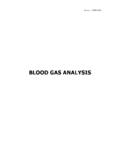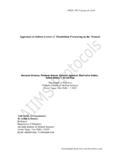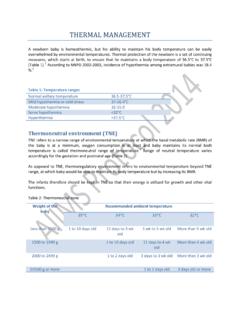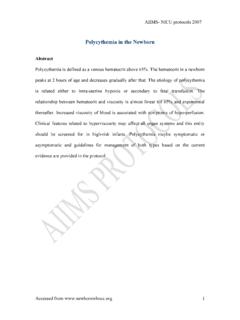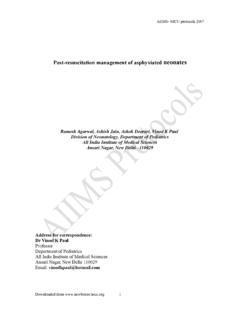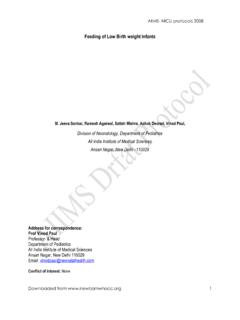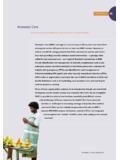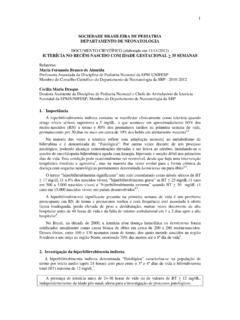Transcription of Jaundice in the Newborns
1 Jaundice in the Newborns Jaundice is the most common morbidity in the first week of life, occurring in 60% of term and 80% of preterm newborn . Jaundice is the most common cause of readmission after discharge from birth Jaundice in neonates is visible in skin and eyes when total serum bilirubin (TSB) concentration exceeds 5 to 7 mg/dL. In contrast, adults have Jaundice visible in eyes (but not in skin) when TSB concentration exceeds 2 mg/dL. Increased TSB concentration in neonate results from varying contributions of three factors namely increased production from degradation of red cells, decreased clearance by the immature hepatic mechanisms and reabsoption by enterohepatic circulation (EHC). High serum bilirubin levels carry a potential to cause neurological impairment with serious consequences in a small fraction of jaundiced babies.
2 In most cases, Jaundice is benign and no intervention is required. Approximately 5-10% of them have clinically significant Jaundice that require treatment to lower serum bilirubin levels in order to prevent neurotoxicity. Physiological versus pathological Jaundice Jaundice attributable to physiological immaturity of neonates to handle increased bilirubin production is termed as physiological Jaundice . Visible Jaundice usually appears between 24 to 72 hours of age. TSB level usually rises in term infants to a peak level of 12 to 15 mg/dL by 3 days of age and then falls. In preterm infants, the peak level occurs on the 3 to 7 days of age and TSB can rise over 15 mg/dL. It may take weeks before the TSB levels falls under 2 mg/dL in both term and preterm infants. Pathological Jaundice is said to be present when TSB concentrations are not in physiological Jaundice range, which is defined arbitrarily and loosely as more than 5 mg/dL on first day, 10 mg/dL on second day, and 12-13 mg/dL thereafter in term Any TSB value of 17 mg/dL or more should be regarded as pathologic and should be evaluated for the cause, and possible intervention, such as It may be noted that the differentiation between pathological and physiological is rather arbitrary, and is not clearly defined.
3 Presence of one or more of following conditions would qualify a neonate to have pathological jaundice2: 1. Visible Jaundice in first 24 hours of life. However slight Jaundice on face at the end of first day (say 18 to 24 hr) is common and can be considered physiological. 2. Presence of Jaundice on arms and legs on day 2 3. Yellow palms and soles anytime 4. Serum bilirubin concentration increasing more than mg/dL/hour or more than 5 mg/dL in 24 hours 5. If TSB concentration more than 95th centile as per age-specific bilirubin nomogram 6. Signs of acute bilirubin encephalopathy or kernicterus 7. Direct bilirubin more than to 2 mg/dL at any age 8. Clinical Jaundice persisting beyond 2 weeks in term and 3 weeks in preterm neonates Causes of pathological Jaundice Common causes of pathological Jaundice include: 1. Hemolysis: blood group incompatibility such as those of ABO, Rh and minor groups, enzyme deficiencies such as G6PD deficiency, autoimmune hemolytic anemia 2.
4 Decreased conjugation such as prematurity 3. Increased enterohepatic circulation such as lack of adequate enteral feeding that includes insufficient breastfeeding or the infant not being fed because of illness, GI obstruction 4. Extravasated blood: cephalhematoma, extensive bruising etc Clinical assessment of Jaundice The parents should be counselled regarding benign nature of Jaundice in most neonates, and for the need to be watchful and seek help if baby appears too yellow. The parents should be explained about how to see for Jaundice in babies (in natural light and without any yellow background). Visual inspection of Jaundice (Panel 1) is believed to be unreliable, but if it is performed properly (ie examining a naked baby in bright natural light and in absence of yellow background), it has reasonable accuracy particularly when TSB is less than 12 to 14 mg/dL or so.
5 Absence of Jaundice on visual inspection reliably excludes the Jaundice . At higher TSBs, visual inspection is unreliable and, therefore, TSB should be measured to ascertain the level of All the neonates should be examined at every opportunity but not lesser than every 12 hr until first 3 to 5 days of life for occurrence of Jaundice . The babies being discharged from the hospital at 48 to 72 hours should be seen again after 48 to 72 hours of discharge. The neonates at higher risk of Jaundice should be identified at birth and kept under enhanced surveillance for occurrence and progression of Jaundice . These infants include5: o Gestation<38 wk o Previous baby with significant Jaundice o Visible Jaundice in first 24 hr o Age specific TSB level being above 95th centile (if measured) Inadequacy of breastfeeding is a common cause of exaggerated Jaundice during initial few days (breastfeeding Jaundice ).
6 Breastfeeding problems such as improper positioning and attachment, cracked or sore nipple, engorgement, perceived inadequacy of milk production are very common and require intense and sustained support from health professionals caring mothers and babies. Breastfeeding support must include, in addition to providing adequate information, actual helping the mothers to learn proper positioning and attachment, and adequate measures to address breastfeeding problems. Panel 1 Visual inspection of Jaundice 1. Examine the baby in bright natural light. Alternatively, the baby can be examined in white fluorescent light. Make sure there is no yellow or off white background. 2. Make sure the baby is naked. 3. Examine blanched skin and gums, and sclerae 4. Note the extent of Jaundice (Kramer s rule)6 o Face 5-7 mg/dL o Chest 8-10 mg/dL o Lower abdomen/thigh 12 -15 mg/dL o Soles/Palms >15 mg/dL 5.
7 Depth of Jaundice (degree of yellowness) should be carefully noted as it is an important indicator of level of Jaundice and it does not figure out in Karmer s rule. A deep yellow staining (even in absence of yellow soles or palms) is often associated with sever Jaundice and therefore TSB should be estimated in such circumstances. Measurement of serum bilirubin 1. Transcutaneus bilirubinometry (TcB)4 a. TcB is a useful adjunct to TSB measurement, and routine employment of TcB can reduce need for blood sampling by nearly 30%. However, current devices are costly and has a significant recurring cost of consumables such as disposable tips etc. b. TcB can be used in infants of 35 weeks or more of gestation after 24 hr. TcB is unreliable in infants less than 35 weeks gestation and during initial 24 hr of age.
8 TcB has a good correlation with TSB at lower levels, but it becomes unreliable once TSB level goes beyond 14 mg/dL. c. Hour specific TcB can be used for prediction of subsequent hyperbilirubinemia. TcB value below 50th centile for age would rule out the risk of subsequent hyperbilirubinemia with high probability (high negative predictive value)7 d. Trends in TcB values by measuring 12 hr apart would have a better predictive value than a single e. We routinely perform TcB measurement in infants of 35 wk or more gestation to screen for hyperbilirubinemia. A TcB value of greater than 12 to 14 mg/dL is confirmed by TSB measurement. 2. Measurement of TSB a. Indication of TSB measurement: i. Jaundice in first 24 hour ii. Beyond 24 hr: if visually assessed Jaundice is likely to be more than 12 to 14 mg/dL (as beyond this TSB level, visual assessment becomes unreliable) or approaching the phototherapy range or beyond.
9 Iii. If you are unsure about visual assessment iv. During phototherapy, for monitoring progress and after phototherapy to check for rebound in select cases (such as those with hemolytic Jaundice ) b. Frequency of TSB measurement depends upon the underlying cause (hemolytic versus non-hemolytic) and severity of Jaundice as well as host factors such as age and gestation. In general, in nonhemolytic Jaundice in term babies with TSB levels being below 20 to 22 mg/dL, TSB can be performed every 12 to 24 hr depending upon age of the baby. As opposed to this, a baby with Rh isoimmunisation would require TSB measurement every 6 to 8 hours during initial 24 to 48 hours or so. c. Methods of TSB measurements i. Biochemical: High performance liquid chromatography (HPLC) remains the gold standard for estimation of TSB.
10 However, this test is not universally available and laboratory estimation of TSB is usually performed by Vanden Bergh reaction. It has marked interlaboratory variability with coefficient of variation being up to 10 to 12 percent for TSB and over 20 percent for conjugated ii. Micro method for TSB estimation: It is based on spectrophotometry and estimates TSB on a micro blood sample. It is useful in neonates, as bilirubin is predominantly unconjugated. Approach to a jaundiced neonate: A step wise approach should be employed for managing Jaundice in neonates (Figure 1). All the neonates should be visually inspected for Jaundice every 12 hr during initial 3 to 5 days of life. TcB can be used as an aid for initial screening of infants. Visual assessment (when performed properly) and TcB have reasonable sensitivity for initial assessment of Jaundice .
